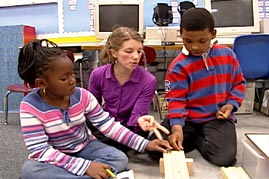Teachers' Domain - Digital Media for the Classroom and Professional Development
User: Preview

Source: WGBH Educational Foundation


Successful science teaching requires good assessment. Assessments may conclude a lesson, while others occur before or during the lesson itself.
Science practices involve a host of skills, attitudes, and knowledge. They may range from setting up a fair experiment, to prediction, observation, and reflection on the process. The teaching of these skills can give elementary students a foundation on which to build in higher-level science classes.
However, in order to evaluate the effectiveness of teaching such skills and content, assessment is necessary to map out progress. It can also help identify gaps or shortcomings in a teacher’s approach.
In this video, teacher Heidi Fessenden builds formative assessment into her lesson by informally gauging her students’ thinking during an experiment concerning balls, ramps, and principles of motion and force.
By asking a series of questions and encouraging a dialogue about the experiment while it is happening, Fessenden is able to test how well her students are developing their content knowledge, methods, and metacognitive skills. In these ways, teachers can gain information on their teaching approach and their students’ learning styles. From there, a teacher can make improvements to the overall educational experience in the classroom.
 Loading Standards
Loading Standards